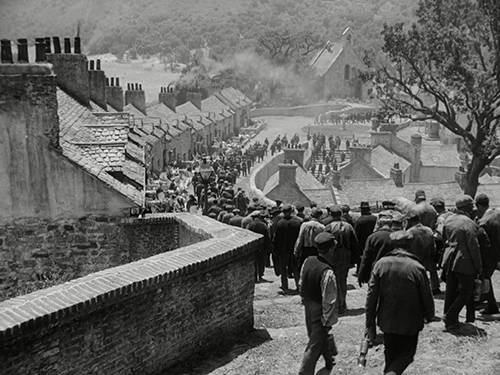
How Green Was My Valley tells of the Morgans, a hard-working Welsh mining family living in the heart of the South Wales Valleys during the 19th century. The story chronicles life in the South Wales coalfields, the loss of that way of life and its effects on the family.
EN
“I am leaving behind me my fifty years of memory – Memory. Strange that the mind will forget so much of what only this moment is past and yet hold clear and bright the memory of what happened years ago – of men and women long since dead. For there is no fence nor hedge round time that is gone. You can go back and have what you like of it. So I can close my eyes on my valley as it is today and see it as it was when I was a boy. Green it was, and possessed of the plenty of the earth...”
Huw in How Green Was My Valley
“What Ford took from his unrestrained forays into expressionism during the late silent period was a heightened form of storytelling that served to expand his stylistic dexterity and allow him a richer range of emotional expression. Tag Gallagher points out that after his exposure to Murnau’s influence, Ford discovered new ways of ‘articulating emotions and moods and states of the soul... Ford found cinema could be completely poeticized.’ As Ford’s style matured in the 1930s, his ‘expressionist temptation’ became more subtly ingrained in his work. To convey the German mother’s heartbreak in Four Sons after her sons have left home to be killed in battle or to find a new life in America, Ford dissolves ghostly images of the boys over the empty places at her dinner table. With simpler, more naturalistic means in his 1941 film How Green Was My Valley, Ford achieves a more devastating effect by using space, silence, and minimal sound effects and dialogue. After his older brothers leave home in rebellion, Huw (Roddy McDowall) and his grieving father (Donald Crisp) sit wordlessly at opposite ends of a long and otherwise empty dinner table. Huw finally bangs his utensils on the table to draw attention, and his father says softly, ‘Yes, my son. I know you are there.’ The comparison between these two scenes demonstrates how much subtler Ford became when he could work with a combination of auditory and pictorial imagery.”
Joseph McBride1
''How Green Was My Valley is a story of dispersal and dissolution, but it’s a tribute to Ford’s powers of suggestion that he could convincingly create an aura of warm nostalgia around a movie about bad marriages, poverty, fatal mining accidents, and violent, family-rending labor disputes, without ever actually betraying the tone of the material.
Ford could glide from the more or less scathing left-wing point of view of Grapes of Wrath to the uneasy centrism of How Green, where unions are justified but bring a heavy cost, because his vision was always more communal than collective, and almost never ideological. In that sense, his lionization by the left in the mid-1930s was a misunderstanding that worked to Ford’s critical advantage.
Criticisms about the film being an inaccurate depiction of a mining town are irrelevant; it is life seen through the eyes of a child. Although it is narrated by a man, the characters are drawn with the broad strokes of an awestruck boy, bathed in the golden glow of an adult’s remembrance of his childhood. And it is one of the most cogent statements of one of Ford’s deepest themes: the way that time’s flow destroys the old ways, which must die in order for the future to take hold. Ianto stands up at the dinner table and says that if manners prevent him from speaking against injustice, then he will be without manners, and we understand both his anger and the pain of his father’s loss of control of his sons, his house, and his life.”
Scott Eyman2
NL
“In How Green Was My Valley (1941) voert John Ford personages op die zorg dragen voor elkaar en de wereld die hen omringt. Zoals het ware bekommernis betaamt, kiemt deze eerst en vooral in kleine gebaren; glimlachen gaat hand in hand met tegenspreken, een schouderklop moet niet onderdoen voor een vuistslag.”
Ignace Wouters1
- 1Ignace Wouters, “Prisma #18,” Sabzian, 23 mei 2018.

